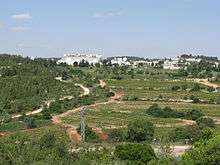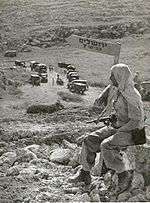Jerusalem corridor

The Jerusalem corridor (Hebrew: פרוזדור ירושלים, Prozdor Yerushalayim) is a geographical district of hundreds of thousands of dunams between Jerusalem and the Shephelah in Israel. Its northern border is the old road to Jerusalem; its southern border, the Elah Valley; and its western border, Shaar HaGai and the road to Beit Shemesh. The largest towns in the Jerusalem corridor are Beit Shemesh, Mevasseret Zion, Abu Ghosh, Tzur Hadassah and Kiryat Ye'arim.
History
In 1949, when the area came under Israeli control, the region was mountainous, rocky and bare of trees and forests. Arab villagers who had practiced terraced farming in the narrow valleys and wadis fled during the war. The Jerusalem corridor was the only route for bringing supplies to besieged Jerusalem. In the Battle of Latrun, Jewish forces attempted to capture Latrun, where Jordanian forces were stationed. Burma Road was built as an alternative.[1]
In the first decade of the State of Israel, a total of 35 agricultural settlements were established in the Jerusalem corridor by new immigrants from Yemen, Kurdistan, North Africa, Romania and Hungary. The JNF employed many of the newcomers in afforestation and land reclamation. Since then it has become one of the largest afforested regions in the country.[2]
Today, in addition to the Jerusalem – Tel Aviv highway (Highway 1), a number of additional routes lead to Jerusalem; route 443 covers the northern part of the corridor. Route 395 leads from Ein Kerem to the coast, via Ramat Raziel and Bet Shemesh, and continues south. Route 386 leads to the Ella Valley, via Bar Giora and Tzur Hadassa. A railway line is active in the corridor, next to the Sorek Stream, which is part of the historical Jaffa–Jerusalem railway.
-

Burma Road convoy
-

Arab Ambush on a Jewish Convoy truck
-

Aftermath of Arab Ambush on a Jewish Convoy truck
-

Israeli war of Independence truck wreck 6-7-1950 Jerusalem Corridor
References
Coordinates: 31°47′00″N 35°06′00″E / 31.7833°N 35.1000°E